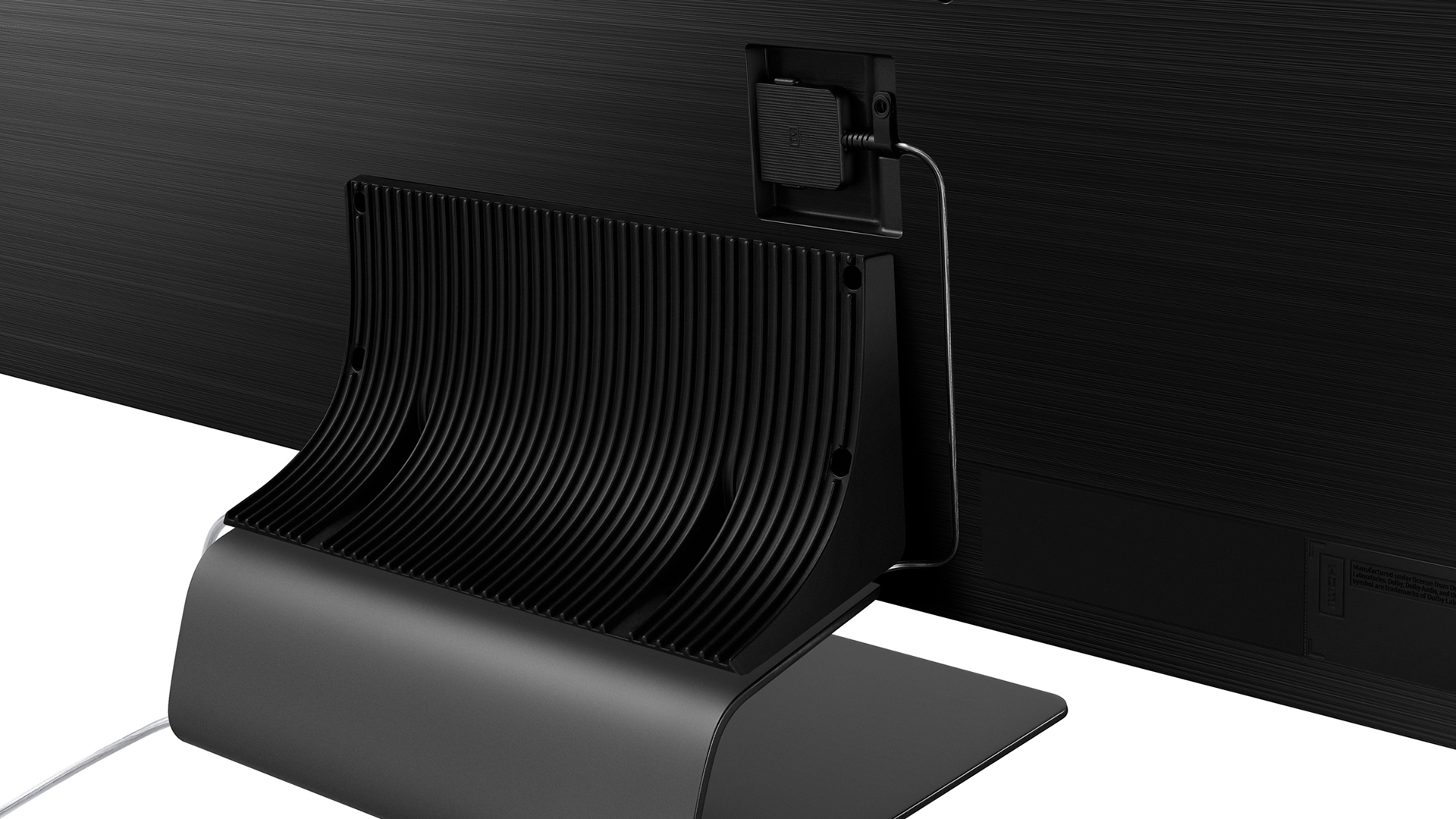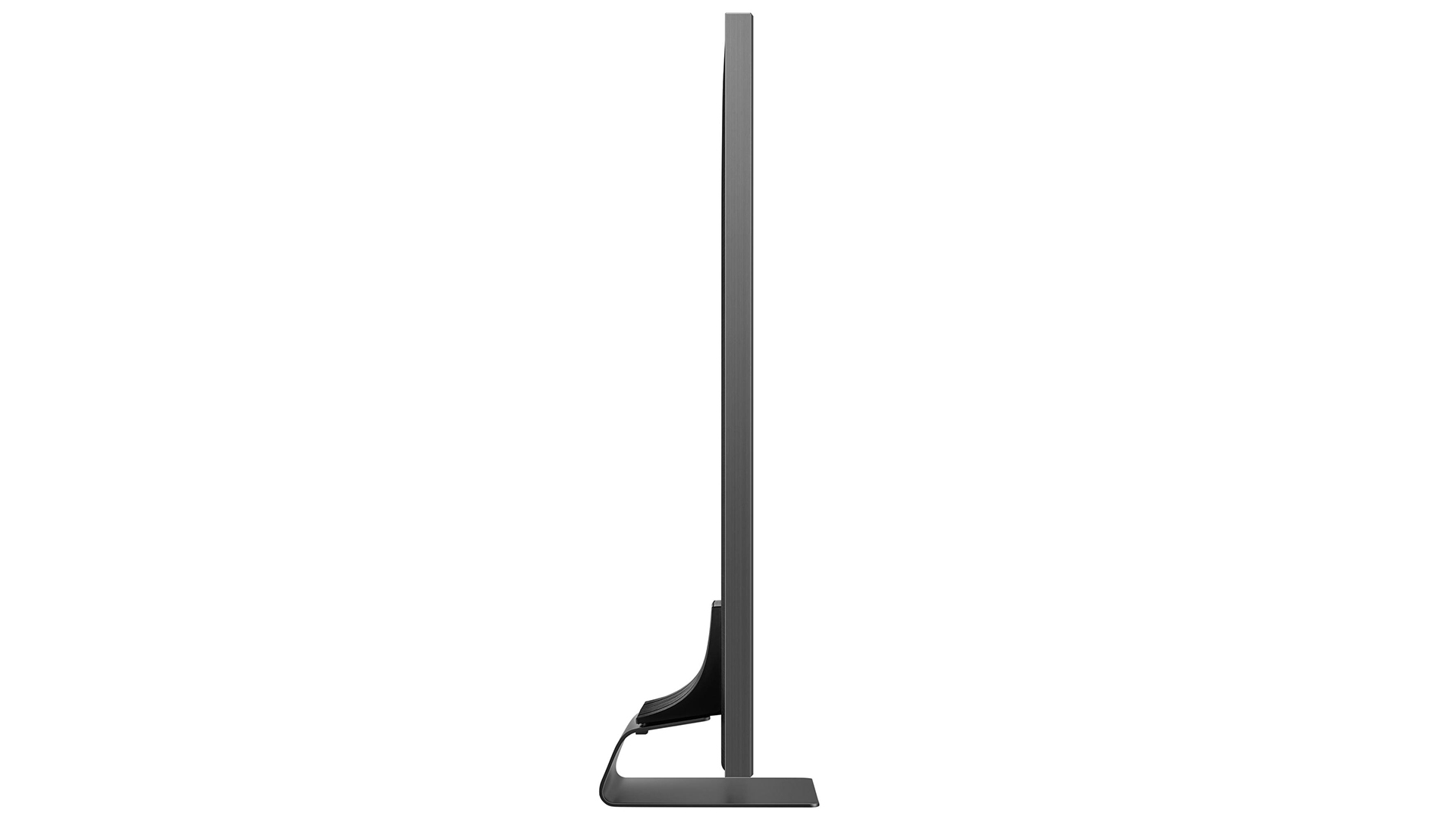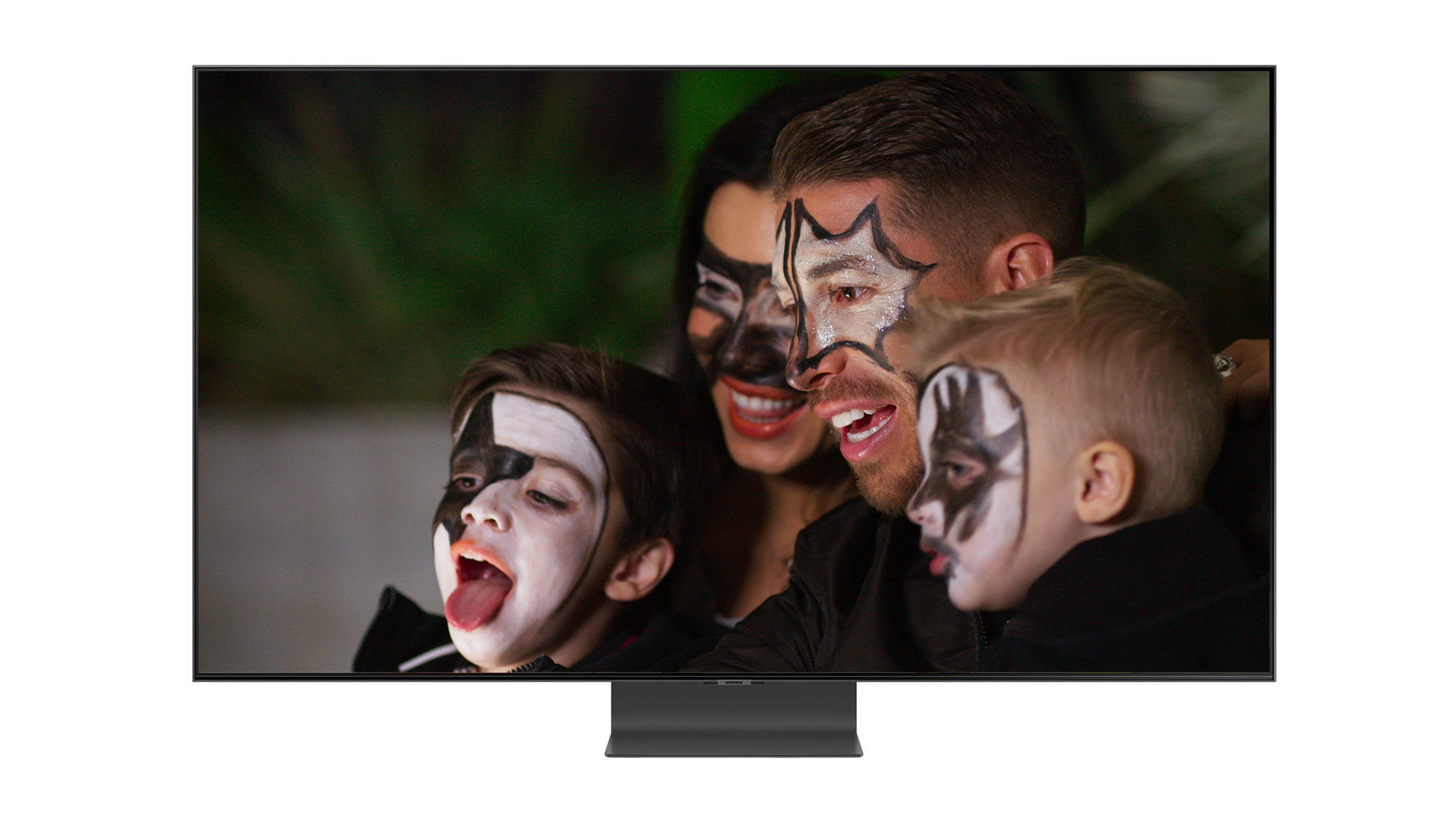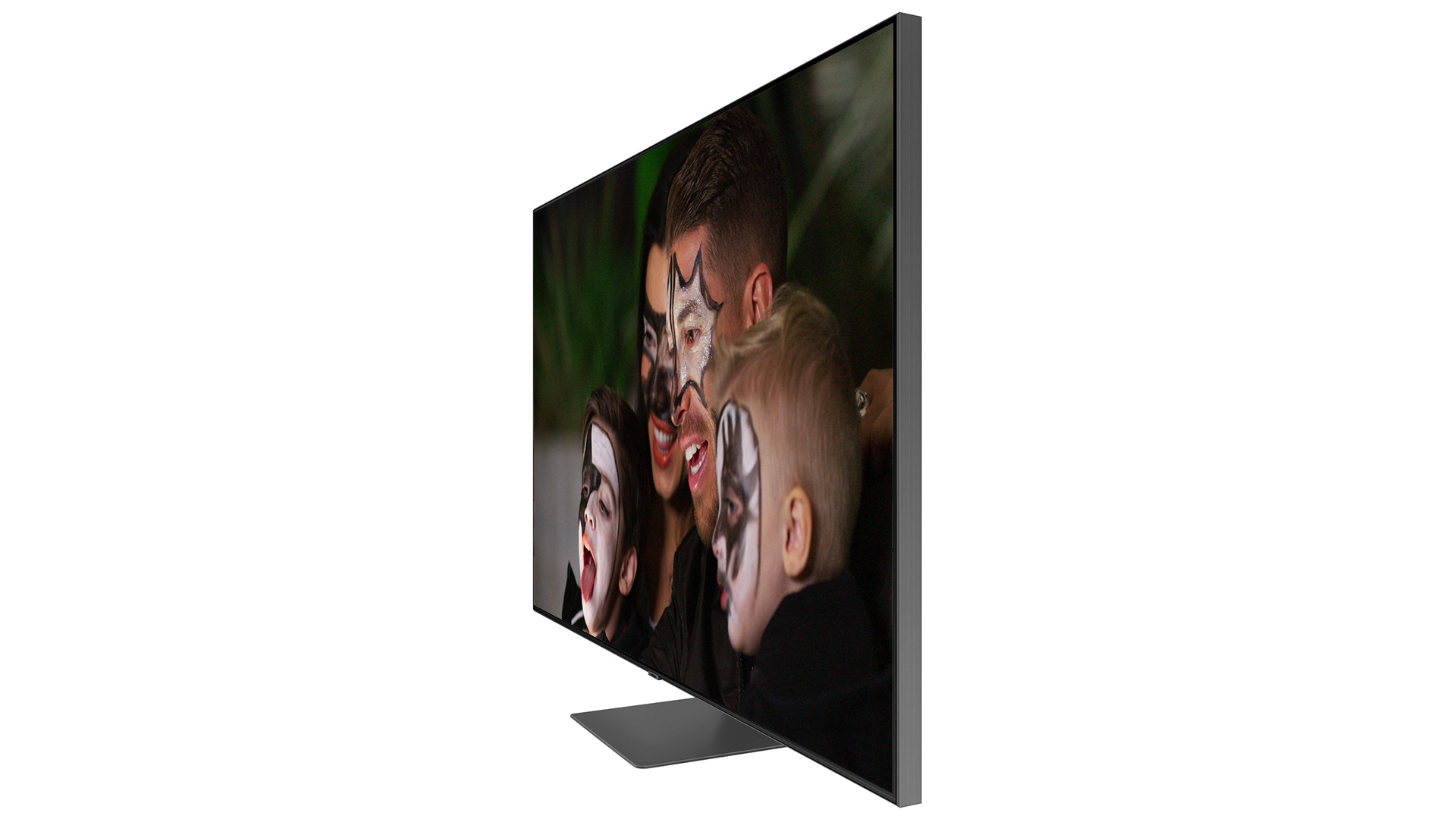What Hi-Fi? Verdict
While it might not be the flagship 4K set we were expecting, the Samsung Q95T is a top 2020 TV
Pros
- +
Rich, solid, natural picture
- +
Very good motion
- +
Improved sound
Cons
- -
‘Predecessor’ was punchier
Why you can trust What Hi-Fi?
Samsung has made some odd decisions regarding its 2020 TV line-up and, while we don't want to get bogged down in model numbers right at the start of a review, it’s worth unpicking the company’s strategy in order to figure out where this TV, the Samsung QE65Q95T, sits in the range.
Last year’s 4K flagship, the Q90R, initially appears to have been replaced by not one, but two models: the Q90T and this Q95T (in fact many countries, the US included, get only the Q90T). The difference between the two is the One Connect system, which sees all connections routed through a separate box – the Q95T has it and the Q90T does not.
However, Samsung says that the Q90R has in fact been replaced by the Q800T, which is an 8K model. We should, therefore, consider the Q95T we have before us as a replacement for last year’s Q85R.
It’s confusing to say the least. If Samsung is so keen for us to not see the Q90/95T as a replacement for the Q90R, why not simply call this model the Q85T and retire the Q90 model number? If a marketing strategy takes this much explanation, it’s probably not a great strategy.
So, what is the Q95T, really? It's the top 4K TV in Samsung’s 2020 TV range, that's what, but it's also in some ways a downgrade on last year’s top 4K model, and it’s hard not to be disappointed by that prospect.
On the other hand, its starting price is much lower than that of the Q90R and, crucially, it’s an excellent performer in its own right.
Features

This is, of course, a QLED model with a direct, full array backlight. But while the Q95T is rated at 2000nits for peak brightness as per the Q90R, the number of dimming zones has been slashed to something closer to that of the Q85R.
Samsung doesn’t release specific numbers, but we understand the Q95T has only around a quarter of the number of dimming zones of the Q90R, which could have a big impact on contrast. The Q95T has an anti-reflective screen, though, and the wide viewing angle tech that Samsung introduced last year.

Screen type QLED
Resolution 4K
Operating system Samsung Tizen
HDR formats HDR10, HDR10+, HLG
HDMI 4
USB 3
Optical 1
There’s a new version of the Quantum Processor 4K too, which brings new features such as Ultimate Precision Processing, designed to reduce banding in lower resolution content, and upgrades to existing features such as Texture Creation (for increased perceived detail) and Active Tone Mapping (for highlights that better combine punch and authenticity).
The sound system has had some serious attention, too, with the Q95T boasting eight drivers – two more than the Q90R and four more than the Q85R. Samsung refers to this arrangement as 4.2.2, but the numbers shouldn’t be interpreted as if it were a Dolby Atmos system. Instead, we’re dealing with four mid-range drivers, two woofers and two tweeters.
Two of the mids are positioned along with the two woofers at the bottom of the chassis and the other two mids and the tweeters are at the top. Samsung says this set-up, which it calls ‘Object Tracking Sound’, produces a bigger, more open and more even sound. While that sounds like Atmos, it’s important to note that the TV doesn’t actually reproduce Atmos soundtracks, though it will pass them from an external source or integrated streaming app to a dedicated sound system using HDMI eARC.
Samsung’s 4K TVs continue to lack official HDMI 2.1 certification, but the company says that they meet the spec in every way a 4K TV can. So, on top of eARC, you can expect support for VRR (Variable Refresh Rate), ALLM (Auto Low Latency Mode), 4K at up to 120Hz refresh rates and dynamic metadata (Samsung uses HDR10+ but not Dolby Vision). The only part of the HDMI 2.1 specification that is missing is support for 8K, which rather makes sense for a 4K TV.
The four HDMI sockets are housed (along with three USBs, an optical audio output, and both aerial and satellite sockets) in the One Connect box, which is connected to the display by a single, almost impossibly thin cable. Even power is sent this way, with the screen itself not needing a direct connection to a wall socket.

We’ve long admired the technical elegance and neatness of the One Connect system but, if you're less enamoured, you can save £200 and buy the Q90T instead. Samsung says that the performance is identical and that the remote control is the only other difference: the Q90T gets a basic, plastic zapper, whereas the Q95T comes with a stylish, stripped back, silver device that also boasts a built-in microphone for operation via Bixby, Alexa or (soon) Google Assistant.
Samsung’s Tizen has been our favourite operating system for a while, so it's not terribly surprising that it's barely changed for 2020. It's gone from white to a pleasant shade of blue in order to reduce eye strain, and icons have been reduced in size so that more can be displayed at once, but that’s about the sum of the upgrades.
The app selection remains the same, too, which is to say that it's exemplary. BBC iPlayer and Now TV were initially missing from our early sample but were added before the TV went on sale. Once added, they joined the likes of Amazon Prime Video, Netflix, Apple TV, Disney+, ITV Hub, All 4, My5, BT Sport, Plex, Spotify and Tidal. AirPlay 2 is also on board, giving Apple users another way to get audio and video content to the TV.
Were you to place the Q95T and Q90R side-by-side you’d be hard-pressed to spot the difference. While dimensions vary slightly (the Q90T is thinner by 5mm), both have the thick, flat edges that make the TV look like a large, high-tech picture frame when wall-mounted, and a soundbar-friendly, Apple iMac-like pedestal stand.
Picture

Before settling in for movie night with the Q95T, it's important to tweak some settings, first of which is to turn off the power-saving features - you'll find them in the menus under ‘Eco Solution’ heading. And, while the Adaptive Picture setting (in the Intelligent Mode menu) is better than before in the way it adjusts the image to ambient lighting conditions, our preference is still to switch it off.
If you're watching HDR content and using the Standard preset, there are really only a couple of other settings that you'll likely feel the need to experiment with: Local Dimming and the motion processing. With the former, our preference is to switch from Standard to High, even though doing so disables the Active Tone Mapping. Not only does High produce a punchier picture, we notice some flicker to bright objects on dark backgrounds, such as the names in a credits sequence, when Standard is selected.
The default motion processing settings are a bigger problem, as they produce noticeable shimmer when faced with even slightly unpredictable movement. That said, the TV’s native motion handling is vastly better than before, so turning the motion processing off entirely or opting for the Custom setting produces excellent results. We go for Custom, as it takes the native naturalism of the TV’s handling and adds smoother, sharper pans without introducing any shimmer or artificiality. In fact, this is probably the best motion we’ve seen in recent years from a TV that isn’t a Sony.
Having made our tweaks, we slot the It 4K Blu-ray into our Oppo UDP-203 and are instantly delighted with the results. The brightest parts of the Q95T’s picture are noticeably less bright than those of the Q90R, presumably because the comparatively low number of dimming zones means it has to be more cautious in terms of contrast, but there’s still plenty of punch, particularly with Local Dimming set to High.
There’s also a degree of authenticity and naturalism to the picture that the Q95T’s predecessors lacked. It's in the colours, which have a rare depth and richness to them; the edges, which are somehow sharp and smooth at the same time and subsequently create a picture that’s fantastically solid without appearing forced; and the detail, which is clear and textured but never exaggerated.
Black levels are excellent, too: almost as deep as those you’d get from an OLED and with more than enough detail to dig up the slimy textures and reflections in the sewers beneath Derry. There’s no hint of blooming, leakage or any other inconsistencies to the backlight, either. No element of the picture is distracting at all, leaving you free to be engrossed with what you’re watching.

We switch to the 1080p Blu-ray of Drive and the Q95T continues to deliver, although we do make some extra tweaks here, reducing Sharpness, switching the Contrast Enhancer to High and reducing Shadow Detail. The resulting image is delightful, combining plenty of punch with deep, contrasting blacks and colours. It’s a rich and vibrant picture, but that effortless naturalism remains and skin tones are very well judged. Detail levels are superb again, with Bryan Cranston’s characterful face resolved with every hair and wrinkle intact.
This is once again a very solid and three-dimensional image that’s mercifully free of any obvious edge enhancement. Motion handling continues to impress, too.
Drop down to standard-def and the Q95T even makes The One Show look decent. Considering the low-resolution signal, the image is clean, controlled and vibrant without being overly vivid.
Serious gamers will also be delighted to read that Samsung’s 2020 TVs have even less input lag than their predecessors. We’re not sure they needed to be any quicker than before, but the 10ms figure will at least see Q95T owners win that particular round of TV spec Top Trumps. There are a number of game-specific picture features to experiment with, too, although we largely prefer those left off.
Sound

Samsung’s new, eight-driver sound system is a solid upgrade. The soundstage is broader, fuller and more spacious than before, and there’s decent weight and dynamism. It all combines to make movie soundtracks more involving and exciting, but there’s no lack of clarity or focus when watching everyday content such as the news.
That said, the audio gets a little shouty when you turn up the volume, and there’s still a slight artificiality to the bass that TVs with physically larger woofers don’t suffer. This is undeniably a step in the right direction and by the standards of TVs at this price the Q95T delivers a good audio performance, but we’d still recommend partnering your new TV with a dedicated sound system if you're able.
Verdict
Samsung has chosen to focus even more on 8K TVs this year, to the extent that while the Q95T is the best 4K TV that the company makes, it’s not the best 4K TV that the company could make. That’s disappointing, for sure, but this is a great TV in its own right.
It’s an improvement on the Q90R (that it doesn’t quite replace) in practically every way. No, it doesn’t go as bright in real terms, and HDR images sizzle a little less as a result, but its performance is richer, more solid and more natural. It’s also a significant step forward in terms of motion and sound.
Crucially, these improvements come at a lower price: the Q95T is a good deal more affordable than the Q90R was at launch.
That said, this is the first 2020 TV we’ve reviewed and most manufacturers haven’t even revealed their pricing yet. Samsung may argue that the Q95T isn’t intended as a rival for LG’s CX OLED, for example, but if the two TVs turn out to be similarly priced, and we suspect that they might, we’re going to consider them against one another.
But that’s a task for another day. In the here and now the Samsung QE65Q95T is an excellent TV, and if it represents what the company can do with one hand tied behind its back, it bodes very well indeed for 2020 TVs in general.
SCORES
- Picture 5
- Sound 4
- Features 5
MORE:
Read our Samsung QE65Q90R review
What Hi-Fi?, founded in 1976, is the world's leading independent guide to buying and owning hi-fi and home entertainment products. Our comprehensive tests help you buy the very best for your money, with our advice sections giving you step-by-step information on how to get even more from your music and movies. Everything is tested by our dedicated team of in-house reviewers in our custom-built test rooms in London, Reading and Bath. Our coveted five-star rating and Awards are recognised all over the world as the ultimate seal of approval, so you can buy with absolute confidence.
-
DANE Would is be possible to use the One Connect Box from Q95T on a Q85R and get the new and improved features?Reply

